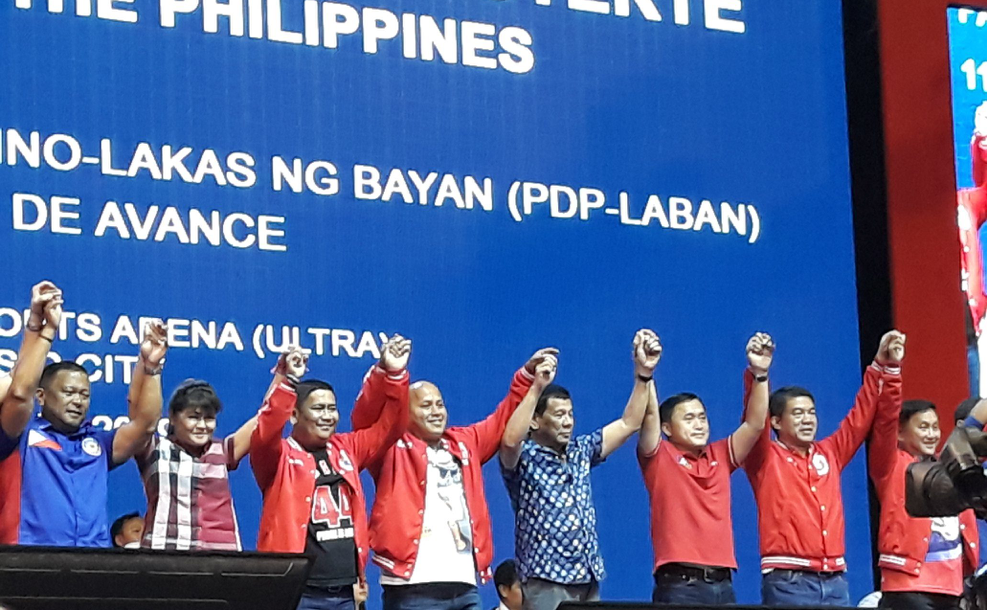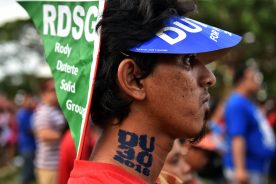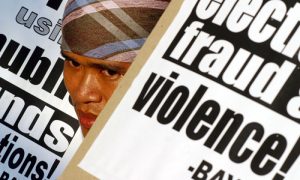The biggest winner in the 2019 midterm elections in the Philippines was not even a candidate—it was President Rodrigo R. Duterte. The 13 May midterms, the fourth since the restoration of electoral democracy in 1986, were generally regarded as a referendum on the first three years of the Duterte presidency.
The elections tested and consolidated Duterte’s political strength as the country’s populist strongman president: most of the national and local candidates endorsed by Duterte won their contests for the 18,066 national and local positions up for grabs. Initial election results point to a victory for the administration’s nine senatorial candidates (out of 12 seats) and a majority of its governors, mayors, and local legislators.
The recent election results follow the historical patterns of midterm elections in the post-1986 period. Political dynasties, which have dominated many of the country’s electoral districts, switch from one dominant presidential party to another in search of patronage. Party-switching has become an institutionalised aspect of the Philippine political system. An average of 33% of congressmen switched parties between 1987 to 2016; of this number, 32% usually affiliate with the president’s party. This is comparable to or higher than Brazil, where party switching is also rampant.
The Partido Demokratikong Pilipino-Lakas ng Bayan (PDP-Laban), the moribund political party that supported Duterte’s presidential candidacy in 2016, ballooned from a party of three elected members to more than 300 as political turncoats switched party affiliations after Duterte’s victory. However, PDP-Laban recently suffered a major setback as most of its members have again switched affiliation to the Hugpong ng Pagbabago (HNP), the regional party established by incumbent Davao City mayor and the president’s daughter, Sara Duterte-Carpio. Meanwhile, the former dominant Liberal Party (LP) has been decimated, with most of its members jumping to the administration parties.
According to the “presidential bandwagon framework”, the introduction of a single term limit for the office of the Philippine presidency destabilised the legislative party system, since legislative candidates now tended to affiliate themselves with the most viable presidential candidates by switching parties. The absence of an incumbent vying for re-election, coupled with weak party loyalties, serve as incentives for potential presidential aspirants to launch new parties and entice legislative candidates to switch parties with the promise of access to patronage.
But unlike previous Philippine presidents, Duterte has not personally endeavoured to consolidate his political support under his dominant party through the systematic mobilisation of patronage. In fact, he did not lift a finger to prevent the ouster of his two closest political lieutenants in Congress—Aquilino “Koko” Pimentel III as Senate President and Pantaleon “Bebot” Alvarez as House Speaker. Pimentel, who ran for re-election for his senate seat in 2019, has struggled to be in the winning circle, while Alvarez managed to eke out a victory against his local competitor.
Patronage to populist mobilisation
One of the characteristics that distinguished the 2019 midterm from previous elections is the emergence of a new presidential bandwagon. The old, traditional presidential bandwagon used material benefits as political currency. As a general pattern, from senators to councillors, incumbents who won at the presidential election year by affiliating with various parties switched to the president’s party by the time of the midterm election. The main motive behind this massive party switching was for the “sake of the constituency”—in other words, for the sake of pork barrel projects which the Malacañang Palace practically controls.
This massive party switching happened between 2016 to 2019, following the usual pattern. What is new, though, is that during the 2019 election the administration candidates did not benefit much from access to the government coffers, but more on the “populist mobilisation” of Duterte.
Unlike previous presidential administrations, which made sure that they had control of the annual budget-making process (which is the usual source of patronage) through indirect control of the leadership of Congress (specifically the House of Representatives), Duterte allowed competing factions of his supporters to openly compete, first for the house speakership, then second, for control of billions of pork barrel funds intended to be used for the midterm elections. As a result of this contestation, the passage of the 2019 national budget was delayed for four months—too late to be mobilised for election spending. Moreover, Duterte vetoed PHP95 billion in appropriations inserted in the Department of Public Works and Highways (DPWH)—the usual source of campaign funds for administration candidates. Further, an investigative report revealed that the presidential vetoes of pork barrel items yielded the heaviest loss for the Davao Region, where Duterte’s support base lies. This suggests that Duterte is rather indifferent to supporting his endorsees through patronage.
Indeed, Duterte has been able to eschew patronage-based political party building in favour of populist mobilisation, defined by political scientist Paul D. Kenny as “a strategy to build a mass of supporters to gain and retain power with the minimum of institutional intermediation”, or by Robert S. Jansen as a “sustained, the large-scale political project that mobilizes ordinarily marginalized social sectors into publicly visible and contentious political action, while articulating anti-elite, nationalist rhetoric that valorizes ordinary people.”
Duterte is the first post-1986 president whose popularity rating did not decline by the time of the midterm election, according to the Social Weather Stations survey. Presidents Ramos, Estrada, Arroyo, and “Noynoy” Aquino all saw their satisfaction rating decline soon after taking office, thus the candidates running for the midterm elections had relatively unpopular presidents. Yet presidential bandwagoning still happened, because of the material benefits outlined above. Campaigning with an overwhelmingly popular president was unprecedented for candidates running for the midterm election. (President Corazon Aquino during the 1987 election was in a similar position, but this was not a midterm election).
Air war, ground war and net war
A popular president helps to consolidate “command votes” or blocs of votes, which are gathered and delivered through traditional networks such as political machines and bailiwicks to fight a “ground war.” This was particularly true for Duterte’s three most favoured senatorial candidates—right-hand man, Christopher “Bong” Go, drug war enforcer Ronald “Bato” Dela Rosa, and chief political operator Francis Tolentino. In a field crowded by established national names and incumbents, the three newbies managed to barge into the winning circle. Their close association with the president helped propel their public awareness and conversion of this awareness into actual votes.
Their victory serves to highlight the growing importance of “air war”, or the use of television and radio advertisements in national political campaigns. The air war is crucial in cultivating the so-called “market votes” by way of popularity, as gauged and reflected in regular public opinion surveys. The air war attracts votes, but ground war ensures the delivery and protection of votes. It also necessitates an enormous amount of campaign funds, while ground war entails a tight organisation of personnel. The decision to mobilise either command votes (ground war) or market votes (air war) relies largely on a myriad of factors that include political opportunity, personal attributes and/or resources available to individual candidates or political parties.
Another emerging trend is the “net war”. Since the cost of political advertising has become exorbitantly high for most candidates, the Internet in general, and social media in particular, have become more cost-effective alternatives. Duterte was the first to maximise social media for his electoral victory in 2016. He was also successful in mobilising his online supporters to attack detractors and defend his administration. The net war “mediates” the traditional “ground war” and “air war,” which candidates typically wage, often with hefty campaign budgets.
Battle of narratives
The LP-led opposition coalition (oddly named “Otso Diretso” or “Straight Eight”) was barely able to form a complete senatorial slate (there were twelve contested seats elected through a multimember plurality system) and one of its key leaders, defeated presidential candidate Mar Roxas, opted to run an independent senatorial campaign while remaining in the opposition slate.
The opposition tried to make Duterte the main issue in their campaign, pointing to his bloody war on drugs, alleged corruption, and close ties with China. Yet Duterte succeeded in deflecting the attacks and making the midterm election a referendum on the track record of the LP. The previous LP-led administration of President Benigno “Noynoy” Aquino III was beleaguered by accusations of incompetence and lack of social empathy. Aquino’s administration drew flak for its handling of the aftermath of the strongest storm to hit Central Philippines—Super Typhoon Haiyan (known as Yolanda in the Philippines); a botched anti-terror mission in Mamasapano in Muslim Mindanao which led to the death of 44 members of an elite unit of the police force; the monstrous traffic crisis in Metro Manila, extortion rackets at the airport, and the mismanagement of LRT and MRT railway systems.
Did Duterte change the rules of Philippine elections?
Dutertismo still hasn’t fundamentally changed how political power is sought and won.
Previous presidents did criticise the opposition, but kept a certain level of civility. A general pattern in the past was that the opposition slate attacked the administration, and the administration defended itself. But Duterte the populist was relentless. Duterte’s campaign tactics was typical mobilisation of the “populist publics.” Duterte supporters are called “Dutertards” (a contraction of “Duterte” and “retard”) by the LP’s supporters (who fancy themselves as “decent Filipinos”). However, as Cleve Arguelles argues, the populist publics are not irrational, dumb or gullible voters: they are part of a growing constituency who have been frustrated, angered, and sceptical of the “hypocrisy” of liberal reformism. As one Duterte supporter colourfully puts it “[we] support Duterte because [we] are Duterte.”
After the midterm
In the 18th Congress that will start after this midterm election, the opposition has practically vanished. In the House of Representatives, only 18 out of 297 are LP members. In the Senate, there are only four de facto opposition members and one of them, Leila de Lima, is detained and thus cannot participate in the decision-making. A staunch Duterte critic of the 17th Congress, Senator Antonio Trillanes IV, ended his second term. For the opposition to survive until the 2022 election, a new coalition, possibly mobilising millennials, would be needed.
Given the composition of the Congress, the president’s legislative agenda is likely to become law if he wishes. These include the bills reinstating the death penalty and reforming the corporate income tax and tax incentives. It is also possible to revive the initiative for constitutional reform that had met resistance during the 17th Congress. In having the Congress to roll over presidential agenda, Duterte is likely to continue his populist mobilisation.
Cracks in Duterte’s popularity may appear when credible corruption charges emerge, as happened to President Estrada in 2000. So far, however, none of the allegations made against the president or his family members are sticking. Aside from corruption, possible flashpoints that can reverse Duterte’s popularity have to do with the China question: China’s expansionism, and the influx of Chinese workers.
2022 and beyond
The race for the 2022 presidential election had already started during the midterm election. Many speculate that the launch of HNP by Sara Duterte-Carpio in 2018 was practically the indication of her bid for presidency in 2022. Following the footsteps of her father, Sara Duterte-Carpio is likely to rely on populist mobilisation.
Other leading presidential contenders include the Villars (either former Senator Manny or his wife and newly-reelected Senator Cynthia), Grace Poe, Manny Pacquiao, Bongbong Marcos, Alan Peter Cayetano, and Ping Lacson. While anything can happen by the time of the next presidential election, major presidential contenders might very well adopt Duterte-style campaign strategies—and the Philippines’ new presidential bandwagon might continue beyond Duterte.
 Facebook
Facebook  Twitter
Twitter  Soundcloud
Soundcloud  Youtube
Youtube  Rss
Rss 



